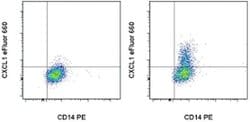Learn More
Invitrogen™ CXCL1 (GRO alpha) Monoclonal Antibody (KTYFLF), eFluor™ 660, eBioscience™
Mouse Monoclonal Antibody
Supplier: Invitrogen™ 50751542

Description
Description: This KTYFLF monoclonal antibody reacts with human CXCL1 and has no cross-reactivity to human CXCL2 or CXCL3. CXCL1, or GRO (growth-related oncogene) alpha, is a pro-inflammatory CXC chemokine first identified by its constitutive overexpression in some tumors. It is closely related to CXCL2 (GRO beta) and CXCL3 (GRO gamma), with which it shares 90% and 86% sequence homology, respectively. These proteins, along with IL-8 or CXCL8, were later found to be critical for neutrophil mobilization and degranulation, as well as vascular permeabilization and angiogenesis. Signaling occurs through the G protein-coupled receptor CXCR2, which is shared with GRO beta and gamma. CXCR2 can also be activated by IL-8, although some studies suggest that the majority of IL-8 activity on neutrophils is mediated by CXCR1. CXCL1 is secreted by monocytes, epithelial cells, and fibroblasts in response to pro-inflammatory stimuli such as LPS, IL-1 beta, and TNF alpha. Overexpression is observed in many malignant tumors, where it contributes to tumor vascularization and metastasis. Applications Reported: This KTYFLF antibody has been reported for use in intracellular staining followed by flow cytometric analysis. Applications Tested: This KTYFLF antibody has been pre-titrated and tested by intracellular staining followed by flow cytometric analysis of peripheral blood monocytes. This can be used at 5 μL (0.125 μg) per test. A test is defined as the amount (μg) of antibody that wi...
CXCL1, CXCL2, and CXCL3, also known respectively as GRO alpha, GRO beta (MIP-2 alpha) and GRO gamma (MIP-2 beta), are members of the CXC subfamily of chemokines. Mature CXCL1/2/3 proteins bind with high affinity to the IL-8 receptor type B and are potent neutrophil attractants and activators. In vitro, the processed forms GRO-alpha(4-73), GRO-alpha(5-73) and GRO-alpha(6-73) show a 30-fold higher chemotactic activity.
Specifications
| CXCL1 (GRO alpha) | |
| Monoclonal | |
| 5 μL/Test | |
| PBS with BSA and 0.09% sodium azide; pH 7.2 | |
| P09341 | |
| Cxcl1 | |
| Affinity chromatography | |
| RUO | |
| 2919 | |
| 4°C, store in dark, DO NOT FREEZE! | |
| Liquid |
| Flow Cytometry | |
| KTYFLF | |
| eFluor 660 | |
| Cxcl1 | |
| alpha-chemokine; C Cmotif chemokine; C X C motif chemokine; CC motif chemokine; CCmotif chemokine; chemokine (C-X-C motif) ligand 1; chemokine (C-X-C motif) ligand 1 (melanoma growth stimulating activity, alpha); Cinc1; CINC-1; CXC; CXC motif chemokine; C-X-C motif chemokine 1; C-X-C motif chemokine ligand 1; CXCL; CXCL1; CXCL-1; Cytokine-induced neutrophil chemoattractant 1; fibroblast secretory protein; Fsp; Gro; GRO a; GRO a; Gro1; GRO1 oncogene; GRO1 oncogene (melanoma growth stimulating activity, alpha); GRO1 oncogene (melanoma growth-stimulating activity); GROa; GROalpha; GRO-alpha(1-73); GRO-alpha(4-73); GRO-alpha(5-73); GRO-alpha(6-73); Growth-regulated alpha protein; GROa; Hematopoietic synergistic factor; HSF; KC; KC(5-72); KC/GR)-alpha; KC/GRO-alpha; KC-T; melanoma growth stimulating activity, alpha; Melanoma growth stimulatory activity; melanoma growth stimulatory activity alpha; MGSA; MGSA alpha; MGSA-a; N51; NAP3; NAP-3; Neutrophil-activating protein 3; platelet-derived growth factor-inducible protein KC; SCYB1; secretory protein N51 | |
| Mouse | |
| 100 Tests | |
| Primary | |
| Human | |
| Antibody | |
| IgG1 κ |
Safety and Handling
The Fisher Scientific Encompass Program offers items which are not part of our distribution portfolio. These products typically do not have pictures or detailed descriptions. However, we are committed to improving your shopping experience. Please use the form below to provide feedback related to the content on this product.

